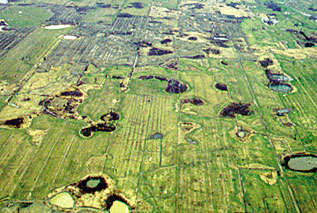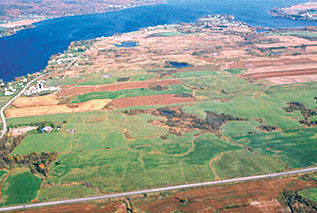 |
Atocas Bay and the Alfred Bog
Historically, wetlands comprised 50% of the land
base around Alfred but European settlement introduced
intensive land-use practices including forestry,
agriculture and peat mining, which eliminated 80%
of the original wetlands. Today the Alfred Bog and
this pothole complex, which includes Atocas Bay,
are the only significant post-settlement wetlands
that remain.
Alfred Bog is eastern Ontario’s largest wetland,
providing habitat for several rare species including
the bog elfin and numerous orchids. The Atocas Bay
pothole area, a geological feature unique to Ontario,
has depressions which were most likely caused by
a liquification of a 20-metre-deep sand layer below
the surface of this once relatively flat, deep lacustrine
clay area. This liquification was most likely caused
about 7000 years ago by a major earthquake and an
up-welling of sand volcanoes.
The various Atocas Bay wetlands range from 1 to
10 hectares in size and include sedge meadows, cattail
marshes, shrub swamps and shallow open-water lakes.
Of those basins that were drained for agricultural
purposes, 80% have been restored due to the efforts
of Ducks Unlimited Canada in 2001. Local wetland
species include otters, moose, deer, painted and
snapping turtles, and several waterfowl species. |
| |
|
|
 |
Riverside Neighbours
English-speaking settlers came to Alfred County
in 1800 and settled near the Atocas stream but it
was the French from Vaudreuil QC, who followed that
soon formed the majority of the poplulation. From
this small settlement great quantities of pressed
hay were shipped overseas to feed the English cavalry
during the Boer War in South Africa, 1899 to 1902.
Today, Alfred is known as the French Fry Capital
of Canada.
Alfred College, built in 1933 as a rehabilitation
centre for young offenders, houses the Alfred College
of Agriculture and Food Technology that is affiliated
with the University of Guelph. It is the only French-language
agricultural teaching and research institution in
Ontario. In 1849 Pierre Lefaivre settled in this
dense forest of oak, cherry, maple, ash and elm.
By 1867, a settlement of 60 settlers was established
and the first of a series of sawmills was erected
on Presqu’ile Point.
For over 30 years the Lefaivre docks were the focal
point of the community. Steamboat passengers, merchandise,
pressed hay and livestock came and went from this
point on the Ottawa River. Each fall the docks were
lined with barrels of molasses giving the impression
that the locals ate nothing else, and thus were
named ‘les mangeux de mélasse’
– the molasses eaters. In 1860 the Prince
of Wales stopped in Lefaivre on his way to Ottawa
to lay the cornerstone for the new Parliament Buildings. |
| |
|
